A flip-flop in digital electronics is a circuit with two stable states that can be used to store binary data. The stored data can be changed by applying varying inputs. Flip-flops and latches are fundamental building blocks of digital electronics systems used in computers, communications, and many other types of systems. Both are used as data storage elements.
It is the basic storage element in sequential logic. But first, let’s clarify the difference between a latch and flip-flops.
Flip-Flop v/s Latch
The primary difference between a latch and a flip-flop is a gating or clocking mechanism.
In Simple words. Flip Flops are edge-triggered and a latch is level-triggered.
If you are confused between latch and flip-flop, then you should check this detailed article where we discussed the difference between Latch and flip-flop.
For example, let us talk about SR latch and SR flip-flops. In this circuit when you Set S as active, the output Q will be high and Q’ will be Low. This is irrespective of anything else. (This is an active-low circuit; so active here means low, but for an active high circuit, active would mean high)
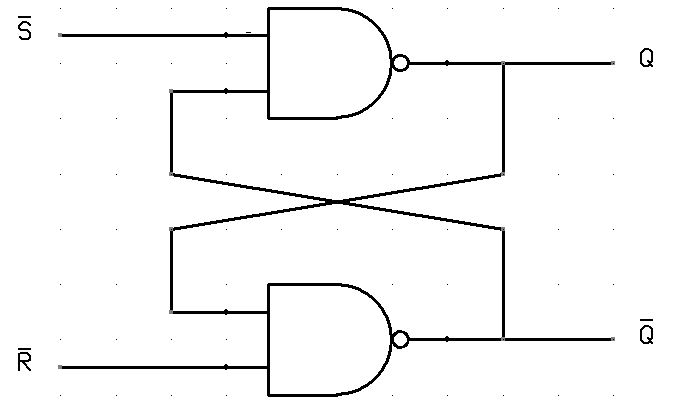
A flip-flop, on the other hand, is a synchronous Circuit and is also known as a gated or clocked SR latch.
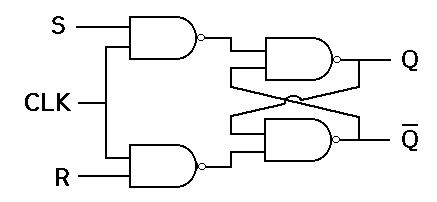
In this circuit diagram, the output is changed (i.e. the stored data is changed) only when you give an active clock signal. Otherwise, even if the S or R is active, the data will not change.
Let’s understand the flip-flop in detail with the truth table and circuits.
Flip Flop Types
There are 4 types of flip-flops in digital electronics:
- SR Flip-Flop
- JK Flip-Flop
- D Flip-Flop
- T Flip-Flop
Let’s understand each Flip-flop one by one.
1. SR Flip Flop
This is the most common flip-flop among all. This simple flip-flop circuit has a set input (S) and a reset input (R). In this system, when you Set “S” as active, the output “Q” would be high, and “Q‘” would be low. Once the outputs are established, the wiring of the circuit is maintained until “S” or “R” goes high, or power is turned off.
As shown above, it is the simplest and easiest to understand. The two outputs, as shown above, are the inverse of each other. The truth table of SR Flip-Flop is highlighted below.
| S | R | Q | Q’ |
| 0 | 0 | 0 | 1 |
| 0 | 1 | 0 | 1 |
| 1 | 0 | 1 | 0 |
| 1 | 1 | ∞ | ∞ |
Recommended: SR Flip Flop Explained
2. JK Flip-Flop
Due to the undefined state in the SR flip-flops, another flip-flop is required in electronics. The JK flip-flop is an improvement on the SR flip-flop where S=R=1 is not a problem.
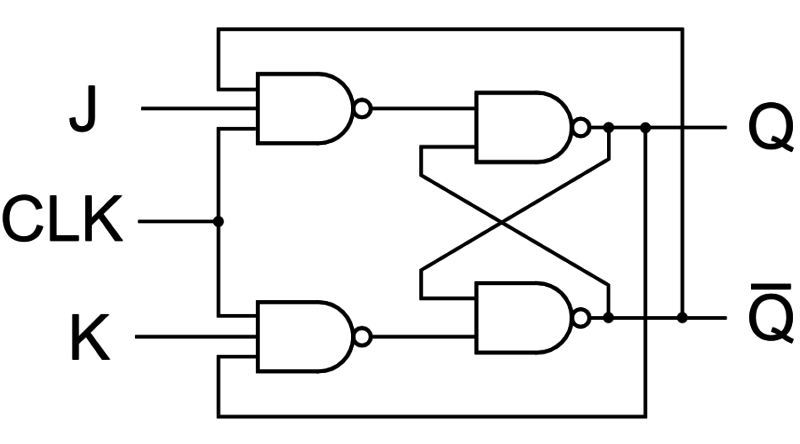
The input condition of J=K=1 gives an output inverting the output state. However, the outputs are the same when one tests the circuit practically.
In simple words, If J and K data input are different (i.e. high and low), then the output Q takes the value of J at the next clock edge. If J and K are both low, then no change occurs. If J and K are both high at the clock edge, then the output will toggle from one state to the other. JK Flip-Flops can function as Set or Reset Flip-flops.
JK FF Truth Table:
| J | K | Q | Q’ |
| 0 | 0 | 0 | 0 |
| 0 | 1 | 0 | 0 |
| 1 | 0 | 0 | 1 |
| 1 | 1 | 0 | 1 |
| 0 | 0 | 1 | 1 |
| 0 | 1 | 1 | 0 |
| 1 | 0 | 1 | 1 |
| 1 | 1 | 1 | 0 |
Also Read: Everything you need to know about JK Flip Flop
3. D Flip-Flop
D flip-flop is a better alternative that is very popular with digital electronics. They are commonly used for counters, shift registers, and input synchronization.
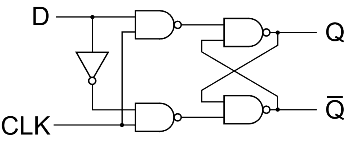
In the D flip-flops, the output can only be changed at the clock edge, and if the input changes at other times, the output will be unaffected.
Truth Table:
| Clock | D | Q | Q’ |
| ↓ » 0 | 0 | 0 | 1 |
| ↑ » 1 | 0 | 0 | 1 |
| ↓ » 0 | 1 | 0 | 1 |
| ↑ » 1 | 1 | 1 | 0 |
The change of state of the output is dependent on the rising edge of the clock. The output (Q) is the same as the input and can only change at the rising edge of the clock.
Recommended: D Flip Flop Working and Applications
4. T Flip-Flop
A T flip-flop is like a JK flip-flop. These are single-input versions of JK flip-flops. This modified form of the JK is obtained by connecting inputs J and K together. It has only one input along with the clock input.
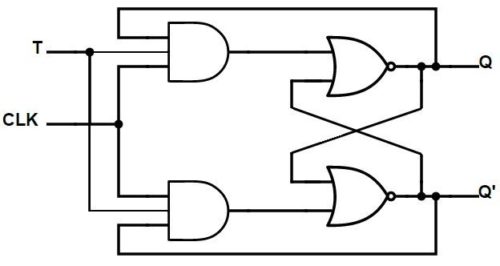
These flip-flops are called T flip-flops because of their ability to complement their state i.e. Toggle, hence they are named Toggle flip-flops.
Truth Table:
| T | Q | Q (t+1) |
| 0 | 0 | 0 |
| 1 | 0 | 1 |
| 0 | 1 | 1 |
| 1 | 1 | 0 |
Also Read: T Flip Flop Working
Applications
These are the various types of flip-flops being used in digital electronic circuits and the applications of Flip-flops are as specified below.
- Counters
- Frequency Dividers
- Shift Registers
- Storage Registers
You can also check this PowerPoint presentation to learn more about Flip-flops in Digital Electronics.
We hope this article helped you understand Flip-Flops in digital electronics.
Still, if you have any doubts, please feel free to ask in the comment section below, or you can use our Forum to start a discussion with the electronics hobbyists and engineers community.
People Also Ask
Why is it Called Flip-flop in Digital Electronics?
A flip-flop is a type of circuit that can store and recall a single bit of information. Its name comes from its ability to “flip” or “flop” between two stable states. By latching a value and changing it when triggered by a clock signal, flip-flops can store data over time. They are called flip-flops because they have two stable states and switch between them based on a triggering event.
What Device is a Flip-flop?
A flip-flop is not a specific device but rather a term used to describe a group of sequential logic circuits. These circuits made up of digital logic gates and other components, can be created using different electronic elements like transistors, integrated circuits (ICs), or programmable logic devices (PLDs).
What’s the Major Role of Flip-flops in Computer Electronics?
Flip-flops play a critical role in computer electronics by serving as memory elements, storing state information, ensuring clock synchronization, enabling digital counting, and facilitating control logic. They are essential for data storage, sequencing, coordination, and control within a computer system.
This article was first published on 17 August 2017 and was updated in May 2024.







simple for me to understand good
i think the diagram for SR – flip flop is wrong dude.
No bro
Yeah, the AND gates are supposed to be OR gates. Funny huh
you are wong
they are suppose to be or gates. you are wrong
He is right and so are you. There’s 2 ways to make an S-R latch.
The most common one is using AND gates followed my NOR gates.
The second way is using only NAND gates like he is using above.
the only difference is when we activate S and R at the same time (which is to be avoided)
hi
Shouldn’t the second row second column element of Truth table for T-flip flop be ‘0’ instead of ‘1’? i.e., when T = 1 and Q = 0 the output is 1.
good
well explained
Thank you for your feedback.
your second row of t flip flop is wrong please correct it many student refer your site . So rectify as soon as possible .
Exactly it’s a rs flip flop
what is the correction dude?
Excellent
Hi, I would like to construct a single touch switch using a D flip flop IC, 555 timer, 5v relay module and a capacitive touch pad. So how do i connect the D flip flop to the touch switch circuit for it to work. please i need a reply.
This article needs correction. A D-latch isn’t the same thing as a D Flip flop
It’s good
Thank You for your feedback.
Anyone please clarify what does the author mean by the jargon ‘clock edge’. What does he mean exactly?
Can you give this JK flip flop IC implementation?